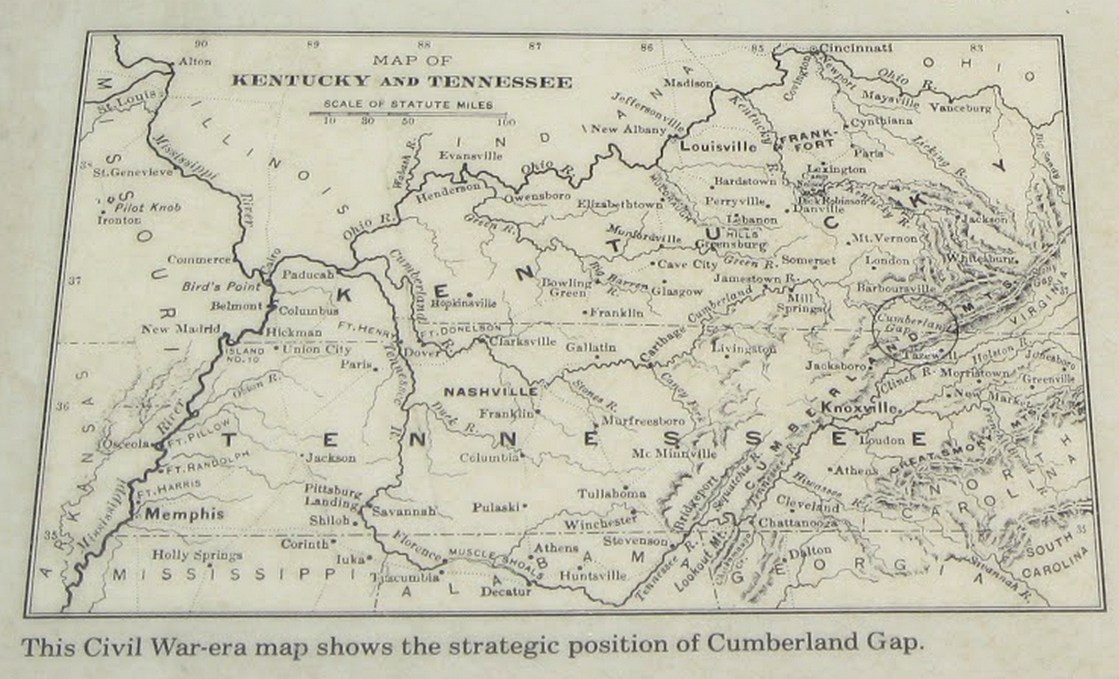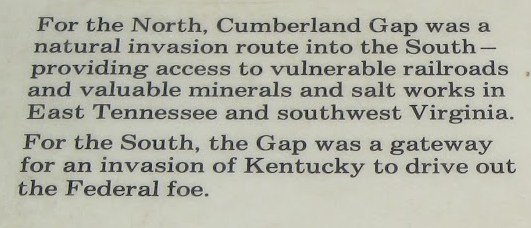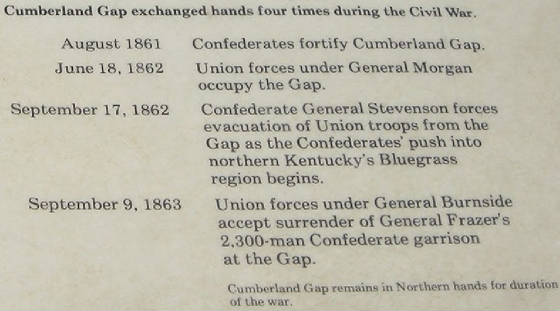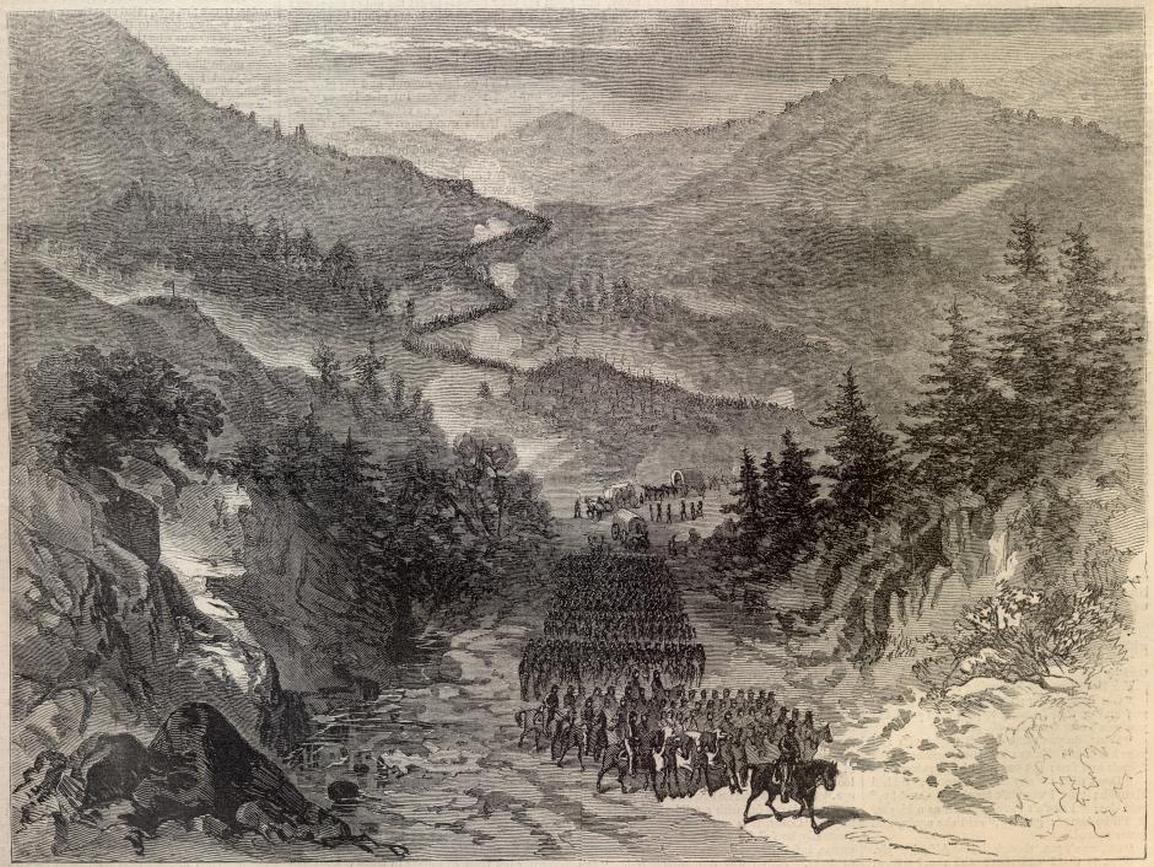|
"Cumberland Gap" in the American
Civil War
General Ulysses S. Grant,
while traveling through the Cumberland Gap in 1864, noted: "With two brigades of the Army of the Cumberland I could hold
that pass against the army which Napoleon led to Moscow."
Introduction
General Grant knew
the importance of securing the Cumberland Gap during the Civil War, having resided in neighboring states for most of
his life he was also familiar with its strategic history. The Army of the Cumberland, a Union army, was also named for
the region. As a direct result of Confederate Gen. John W. Frazer surrendering his command without any attempts of fighting
the enemy or evading capture, 44% of the 62nd North Carolina's soldiers died within
18 months of their incarceration in a single Union prison.
Major B. G. McDowell, 62nd North
Carolina, stated that "When I was told by General Frazer that I had been surrendered, and that I and my regiment were prisoners
of war my indignation and that of my regiment knew no bounds. I informed him that I would not be made a prisoner of war that
it took two to make such a bargain as that under the circumstances, and that he could not force me to do so. Sharp words were
exchanged, and I called up all of the Sixty-second Regiment who were willing to take their lives in their hands and all of
the other commands in the Gap who were willing to join us, and said to them, "If you will go with me we will go out from
here, and let consequences take care of themselves."
In late December 1862, while guarding bridges and railroads in East Tennessee,
three poorly armed companies (295 soldiers) of the 62nd North Carolina
Regiment were captured by a Union cavalry force of 3,000. The 62nd continued to serve and fight in East Tennessee until 442 of its men were surrendered
to Union forces in the Cumberland Gap on September 9, 1863, by General Frazer, who many consider a coward for not fighting
nor trying to evade capture, but as many as 200 soldiers from the 62nd evaded capture and in April 1864 the unit mustered
178 men in Asheville. The bulk of the fighting at the Battle of Asheville one year later, April 6, 1865, and just three days prior to Lee surrendering to
Grant, was shouldered by the remaining 175 steadfast warriors who formed the ranks of the depleted unit for its
final mustering.
| Cumberland Gap and the Civil War |

|
| The Majestic Cumberland Gap and the Civil War |
Confederate General John W. Frazer surrenders
the Cumberland Gap
Frazer
believed that he was outnumbered by Union Gen. Ambrose E. Burnside's army by a margin of at least 5-to-1. Frazer, however,
refused to obey orders to "fight or retreat." Since hundreds of Confederates under Frazer's command evaded capture in
the Cumberland Gap, it is fair to say that Frazer could have, at the very least, evaded
capture.
…Lining up along the Harlan
Road, the Confederates were amazed to see the small
force to which they had surrendered…
General Frazer was a West Point Graduate, New Yorker, and Union Army General John Buford
contemporary. According to the Official Records of Union
and Confederate Armies (hereinafter cited as O.R.), General Frazer had the opportunity to fight, retreat, or evacuate
from the Cumberland Gap and save his command from a "long imprisonment and death." According to several Confederate officers, Frazer
displayed "treachery and cowardice which led to the unconditional surrender of the strongest natural position in the Confederate
States." And with it, "2,026 prisoners, 2,000 small arms, 12 pieces of artillery, and the stores of ammunition and provision.
They also surrendered 200 horses and mules, 50 wagons, 160 cattle, 12,000 pounds of bacon, 2000 bushels of wheat, and approximately 15,000 pounds of flour."
According to the Official Records, on September 9, 1863, General Frazer was credited
for surrendering 2,026 soldiers (including the Sixty-second and Sixty-fourth North Carolina Infantry Regiments) defending the Cumberland Gap. Some believed that Frazer was "bribed to surrender" the Gap. Major,
later Lt. Col., Byron Gibbs McDowell was the only 62nd North Carolina Regimental field officer present during the surrender of the Cumberland Gap. During
the surrender, Commanding Colonel Love was ill and not present and Lt. Col. Clayton had contracted typhoid fever and was in
a hospital in Greenville, Tennessee. In O.R., I, 30, II, pp. 636-637, McDowell discusses the Cumberland Gap's surrender and exclaims
that Frazer's report is "slanderous." Jefferson Davis endorses the report by writing that Frazier's surrender "presents
a shameful abandonment of duty."
| Map of Cumberland Gap during the Civil War |

|
| Civil War Map of Cumberland Gap and its proximity to adjoining regions and states |
| Battle of the Cumberland Gap |

|
| Why was the Cumberland Gap important during the Civil War? |
Sequential official correspondence
with General John Wesley Frazer
Below are excerpts from the Official
Records: O.R., I,
30, II, 602, O.R., I,
30, IV, 571, O.R., I,
30, IV, p. 572, O.R., I,
30, II, p. 617, O.R., I,
30, II, p. 624, O.R.,
I, 30, II, pp. 629-639, and O.R., I, 30, II, pp. 607-615. Also, for its entirety, see General
John Frazer's comments regarding why he surrendered the Cumberland Gap, and Lt. Colonel B. G. McDowell's official report for
the Official Records of the Union and Confederate Armies in O.R., I, 30, II, pp. 607-639
KNOXVILLE AUGUST 21, 1863 (RECEIVED 22ND)
…. My orders
to General Frazer are to defend Cumberland Gap to last.
S. B. BUCKNER
Major-General
KNOXVILLE,
AUGUST 21, 1863
The 65th
Georgia is ordered to reinforce you from Jacksborough [Jacksboro]
with the artillery now at Big Creek Gap. You [General Frazer] are expected to hold your position to the last.
V. SHELIHA
Chief of Staff
LOUDON [TN], AUGUST 30, 1863—p. m.
General Frazer received
message and will carry out your order…
General MacKall
Chief of Staff;
Chattanooga
Loudon [TN],
August 30, 1863
Brigadier-General Frazer
Cumberland
Gap:
You overrate [General]
Burnside’s forces…
V. SHELIHA
Chief of Staff
Loudon [TN],
August 30, 1863
General J. W. Frazer
Commanding Cumberland
Gap:
Hold the Gap according
to my first instructions a week ago…
S. B. BUCKNER
Major-General
Loudon [TN],
August 30, 1863
Brigadier-General Frazer
Cumberland
Gap:
Evacuate your position
at once….notifying Major-General [Sam] Jones of the move. Destroy all stores for which you cannot find transportation.
V. SHELIHA
Chief of Staff
General Frazer:
Evacuate all your forces
as speedily as possible…retire [retreat] to Abington [Abingdon, Virginia,
Cumberland area]. Report your movements by courier and telegraph to General Jones.
S.
B. BUCKNER
Major-General
(Duplicate of above
sent to General A. E. Jackson, Jonesborough, Tenn.)
Maj. Gen. S. Jones
CHATTANOOGA, TENN.
Dublin,
Va.:
September 6, 1863
Send an order to General
Frazer, at Cumberland Gap, to evacuate the gap…
S.
B. BUCKNER
Major-General
Brig. Gen. John S. Williams, Abington [VA], September 11, 1863
Commanding, &.,
Jonesborough:
GENERAL: Since writing
to you this morning I received a dispatch… General Frazer and Cumberland Gap capitulated…
I hope that the report is not true…
| Civil War Battles for control of Cumberland Gap |

|
| One must travel through the Cumberland Gap - or spend weeks going around it |
Colonel
B. G. McDowell
By 12 o’clock
on September 9, 1863, Union officers had already sent four letters to General
Frazer "demanding surrender of the Commanding Confederate forces of the Cumberland Gap." Frazer
inquired of Burnside, “To what is the strength of your army?” Burnside declared, “I can not tell, surrender.”
Major (his rank at
the time) McDowell insisted, "We want to fight! We waited and waited! Then at 4 p.m. we were informed that we were prisoners
of war."
McDowell (a native
of Macon County, N.C.) and about 600 soldiers refused to surrender, and they evaded capture, reformed in Asheville, N.C.,
and fought until the bitter end of the Civil War.
General John W. Frazer
According to Official
Records of the Union and Confederate Armies, Brigadier General John W. Frazer stated the most treacherous and slanderous remarks
about the 62nd North Carolina Regiment: "The discipline and organization were utterly worthless… the
greater part of officers were totally unfitted for command…Colonel Love and Major McDowell, I do not think were qualified
for command…My opinion is this regiment would have broken or thrown down their arms on the first fire from the enemy…There
were numerous desertions…In fact not a week passed without several desertions…We had insufficient arms to fight...I
believed we were greatly outnumbered...I was unsure of the enemy's strength...I thought surrender would save lives...General
Buckner was no where to be found, I wondered what became of him..."
General Frazer died March 31, 1906, in New York, NY.,
and perhaps was not credible with his contradictory remarks about the surrender of the 62nd North Carolina and the Cumberland
Gap. (He underscored his initial contradictory account for the Official Records of the Union and Confederate Armies.) He had ample time to make a retraction or state that he was under duress when he made the
statements. Frazer opined that Union forces numbered 10,000-30,000 under Burnside. Burnside also sent at least four
letters to Frazer demanding surrender and insisted, “We expect your [Frazer] unconditional surrender.”
(O.R., I, 30, II, p. 638 and O.R., I, 30, II, p. 624). General Frazer, moreover, had been ordered to retreat
to a very advantageous position, the high ground; however, he surrendered without a shot. (O.R., I, 30, II, p. 602).
| How to win a battle without firing a shot... |

|
| General Burnside's Union army passing through Cumberland Gap in September 1863, Harper's Weekly |
Closing Remarks
Lt. Col. Byron
Gibbs McDowell a coward? Even after being shot while fighting bushwhackers, McDowell fought valiantly and bravely until the
end of the conflict, and he was also recorded on muster rolls and troop rosters in April 1865. McDowell was a leader
and inspiration to the men who served in his command and he was quick to lead by example. The men who evaded capture,
of their own free will they too fought until the end of the conflict. Their actions were not indicative of cowardice.
Frazer made his blistering remarks while in Union captivity, and, if he was only trying to gain favor while incarcerated,
he could have made a retraction after the war-- but he didn't. Perhaps out of fear for his life, it explains why he
lived his remaining years in New York. Did Frazer sell out as some have suggested? Perhaps. Regardless
of Frazer's motives or excuses, it is evident by the hundreds who had evaded capture, he also could have led many, if
not all, of his command to another position. Frazer was similar to the possum at the Cumberland Gap, and his inaction
and disobedience to orders from his superiors, as well as his lack of leadership, "presents a shameful
abandonment of duty," said Jeff Davis bluntly. There is a lot of truth to that old saying, run away and live to fight another
day. But of the 442 men of the 62nd who were captured in the Cumberland Gap and incarcerated in Union prisons, 44% died. Nearly 750 of the regiment's 1,000 had been captured during the war,
but the remaining 175 who formed the shattered unit were present for the daring defense of Asheville on April 6, 1865.
(See related reading below.)
Recommended
Reading: To
Die in Chicago: Confederate Prisoners at Camp Douglas 1862-65 (Hardcover: 446 pages). Description: The author’s research is exacting, methodical, and painstaking. He brought zero bias to the enterprise and the
result is a stunning achievement that is both scholarly and readable. Douglas, the "accidental" prison camp, began as a training
camp for Illinois volunteers. Donalson and Island #10 changed that.
The long war that no one expected… combined with inclement weather – freezing temperatures - primitive medical
care and the barbarity of the captors created in the author’s own words "a death camp." Stanton's and Grant's policy
of halting the prisoner exchange behind the pretense of Fort
Pillow accelerated the suffering. Continued below...
In the latest
edition, Levy found the long lost hospital records at the National Archives which prove conclusively that casualties were
deliberately “under reported.” Prisoners were tortured, brutality was tolerated and corruption was widespread.
The handling of the dead rivals stories of Nazi Germany. The largest mass grave in the Western Hemisphere is filled with....the
bodies of Camp Douglas dead, 4200 known and 1800 unknown.
No one should be allowed to speak of Andersonville until they have absorbed the horror of Douglas, also known as “To
Die in Chicago.”
Recommended
Reading: East
Tennessee and the Civil War (Hardcover: 588 pages). Description:
A solid social, political, and military history, this work gives light to the rise of the pro-Union and pro-Confederacy factions.
It explores the political developments and recounts in fine detail the military maneuvering and conflicts that occurred. Beginning
with a history of the state's first settlers, the author lays a strong foundation for understanding the values and beliefs
of East Tennesseans.
He examines the rise of abolition and secession, and then advances into the Civil War. Continued below...
Early
in the conflict, Union sympathizers burned a number of railroad bridges, resulting in occupation by Confederate troops and
abuses upon the Unionists and their families. The author also documents in detail the ‘siege and relief’ of Knoxville.
Although authored by a Unionist, the work is objective in nature and fair in its treatment of the South and the Confederate
cause, and, complete with a comprehensive index, this work should be in every Civil War library.
Recommended Reading: War at Every Door: Partisan Politics and Guerrilla
Violence in East Tennessee, 1860-1869. Description: One of the most divided regions of the Confederacy, East Tennessee was the site
of fierce Unionist resistance to secession, Confederate rule, and the Southern war effort. It was also the scene of unrelenting
'irregular,' or guerrilla, warfare between Union and Confederate supporters, a conflict that permanently altered the region's
political, economic, and social landscape. In this study, Noel Fisher examines the military and political struggle for control
of East Tennessee from the secession crisis through the early years of Reconstruction, focusing
particularly on the military and political significance of the region's irregular activity. Continued below...
Fisher portrays
in grim detail the brutality and ruthlessness employed not only by partisan bands but also by Confederate and Union troops under constant
threat of guerrilla attack and government officials frustrated by unstinting dissent. He demonstrates that, generally, guerrillas
were neither the romantic, daring figures of Civil War legend nor mere thieves and murderers, but rather were ordinary men
and women who fought to live under a government of their choice and to drive out those who did not share their views.
Recommended Reading: Portals to Hell: Military Prisons
of the Civil War. Description:
The military prisons of the Civil War, which held more than four hundred thousand soldiers and caused the deaths of fifty-six
thousand men, have been nearly forgotten. Lonnie R. Speer has now brought to life the least-known men in the great
struggle between the Union and the Confederacy, using their own words and observations as
they endured a true “hell on earth.” Drawing on scores of previously unpublished firsthand accounts, Portals to
Hell presents the prisoners’ experiences in great detail and from an impartial perspective. The first comprehensive
study of all major prisons of both the North and the South, this chronicle analyzes the many complexities of the relationships
among prisoners, guards, commandants, and government leaders. It is available in paperback and hardcover.
Recommended Viewing: The Civil War - A Film by Ken Burns. Review: The
Civil War - A Film by Ken Burns is the most successful public-television miniseries in American history. The 11-hour Civil War didn't just captivate a nation,
reteaching to us our history in narrative terms; it actually also invented a new film language taken from its creator. When
people describe documentaries using the "Ken Burns approach," its style is understood: voice-over narrators reading letters
and documents dramatically and stating the writer's name at their conclusion, fresh live footage of places juxtaposed with
still images (photographs, paintings, maps, prints), anecdotal interviews, and romantic musical scores taken from the era
he depicts. Continued below...
The Civil War uses all of these devices to evoke atmosphere and resurrect an event that many knew
only from stale history books. While Burns is a historian, a researcher, and a documentarian, he's above all a gifted storyteller,
and it's his narrative powers that give this chronicle its beauty, overwhelming emotion, and devastating horror. Using the
words of old letters, eloquently read by a variety of celebrities, the stories of historians like Shelby Foote and rare, stained
photos, Burns allows us not only to relearn and finally understand our history, but also to feel and experience it. "Hailed
as a film masterpiece and landmark in historical storytelling." "[S]hould be a requirement for every
student."
Surrender of the Cumberland Gap, Civil War Tennessee, Civil War
Battle Cumberland Gap History, Details, Kentucky, North Carolina, Regiments in the Cumberland Gap Battles, General Ambrose
Burnside
|

